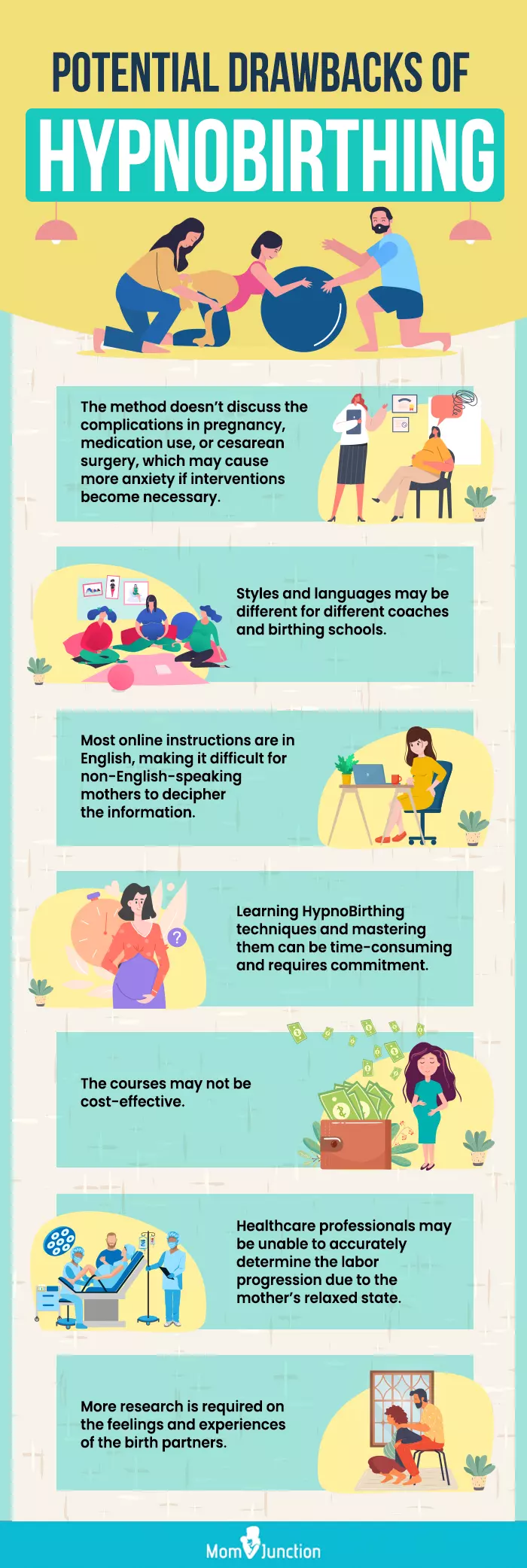
Image: Shutterstock
Pregnant women attend several prenatal classes to learn about safe childbirth practices, alternative pain relief methods, and various labor techniques. HypnoBirthing is one such method that’s gaining popularity worldwide. According to experts, this childbirth approach aims to prepare expecting mothers for the birthing process by teaching specific techniques that help them manage stress, anxiety, fear, and pain during labor and delivery. Also, it focuses on creating a calm and natural birthing experience, which may help reduce the need for emergency or elective cesarean section (1) (2). Read on to learn about the HypnoBirthing techniques, their benefits, and ways to get started.
Key Pointers
- HypnoBirthing helps in pain management during childbirth by reducing stress and anxiety.
- Early breastfeeding initiation and reduced postpartum depression risk are other potential benefits.
- Deep breathing, positive affirmations, visualization, and self-hypnosis are different HypnoBirthing techniques to help mothers feel relaxed.
- HypnoBirthing classes do not discuss pregnancy complications and medical interventions used since they may affect the reality of your birth experience.
How Does HypnoBirthing Work?

HypnoBirthing is a labor philosophy that prepares pregnant women for delivery physically and psychologically. This holistic approach teaches them to accept birth as a natural process and trust their bodies and babies for an easier delivery experience. The method was developed by Marie Mongan, a therapist, and is believed to work on the following principles (2) (3).
- Pregnancy and labor are natural and healthy functions of the female body. However, a woman’s fear and stress about labor pains can exacerbate the experience, leading to increased muscle tension and pain.
- Women can use hypnotherapy as a non-pharmacological approach to reduce fear, anxiety, and pain during labor. It will provide women more control over their bodies and the natural process.
- The relaxation and hypnosis techniques do not guarantee a painless delivery. However, they can help pregnant women develop a positive mindset that can stop negative consequences associated with labor from dominating their minds.
 Did you know?
Did you know?What Are The HypnoBirthing Techniques?
HypnoBirthing helps pregnant women enjoy labor calmly and serenely by reinforcing faith in the spontaneity of labor.
Here are some techniques you can learn to relax your body before and during labor and birth (5):
1. Birth affirmations
These are positive statements that aim to boost confidence, alleviate fear, and create a positive mindset during pregnancy and labor. You may say them aloud, write in a diary, or display them on cards to easily access them whenever needed. Pregnant women may experience a period of discouragement and depression during the third trimester due to increased discomfort and fear of safety during childbirth. So, whether you opt for a home birth, hospital birth, water birth, or vaginal birth after cesarean (VBAC), during these times, affirmations may help effectively combat negative thoughts (6).

2. Visualization
The visualization technique in HypnoBirthing involves imagining a serene location or scene, which can help release tension, reduce fear, and promote relaxation. Alternatively, you can visualize the different stages of labor, making you feel like an active participant in the childbirth process. To enhance the experience, you can use a relaxation script played on an audio device. Remember, the key to visualization is to do what works best for you rather than what others have done or think you should do. It is also recommended to practice visualization during pregnancy to stay prepared for the labor process (7).
3. Deep breathing
Taking slow, deep breaths (inhaling through your nose and exhaling through your mouth) can help reduce discomfort in labor by providing a calming effect (8). When women practice deep breathing, their focus shifts from the pain to rhythmic breathing, helping them feel relaxed. Research shows that controlled breathing has been found to modulate pain perception as it decreases sympathetic nervous system activity and improves emotional regulation (9).
4. Meditation
Meditation may help improve your concentration during labor so that you remain unfazed by the extra noise or things happening around you (8). To meditate, you may focus on something, such as the sound of a bell or your breathing.

5. Self-hypnosis
It is the process of taking oneself into a hypnotic state of deep relaxation where the individual can make suggestions to their mind (10). The goal is to make positive changes in one’s thoughts and feelings, which may help reduce stress and anxiety and have a positive birthing experience.
6. Mindfulness
Mindfulness is the practice of being fully present and engaged in the current moment while non-judgmentally observing one’s thoughts, feelings, and bodily sensations. This approach helps achieve a calm and focused state of mind by releasing distracting thoughts and feelings, reducing stress and anxiety (11).
Practice these techniques throughout pregnancy to gain their full benefits. Speak with a midwife or childbirth professional to receive guidance and professional assistance to put these techniques to practice. You can also include your partner in these classes, to have some bonding time together.
An anonymous mother and a blogger shares her experience with hypnobirthing on her blog. She says, “Hypnobirthing taught me to be in sync with my body, and with the help of prenatal yoga and meditation, I learned to bring myself to a peaceful and calm state, which was very helpful during the labor process. I remember during ‘push time’ (I didn’t push… I breathed my baby out), the nurses were amazed that I was smiling after every surge (contraction). In my head, I just kept focused on the fact that I’ll be meeting my little one soon, and that gave me all the energy I needed! (ⅰ).’’
 Quick tip
Quick tipWhat Are The Benefits Of HypnoBirthing?

HypnoBirthing could help pregnant women (2) (8):
- Gain control and confidence to undergo labor resulting in a more positive birth experience.
- Reduce pregnancy and delivery-related anxiety and fear, especially if you had a previous traumatic experience.
- Alleviate pain perception and shorten the labor duration
- Promote positive mental health after birth and may lower the risk of postpartum depression
- Reduce the requirement for medical interventions and surgery during childbirth (12).
Besides these, HypnoBirthing can help your partner participate more actively during labor, it can be done at home, and it may lead to quicker breastfeeding initiation (13).
 Experts say
Experts sayHow To Get Started With HypnoBirthing?

Several hospitals offer paid HypnoBirthing classes to pregnant women. You may try getting enrolled in such education programs. Alternatively, you may search online for extensive training classes and videos explaining the techniques or read books on HypnoBirthing. Furthermore, you may talk to your midwife or obstetrician for a referral to a professional HypnoBirthing practitioner or instructor with credible certification.
How Does HypnoBirthing Compare To Lamaze And Bradley Method?
HypnoBirthing, the Bradley Method, and Lamaze are natural birthing techniques that aim to make childbirth a positive experience by utilizing breathing and relaxation techniques during labor and delivery, however, they differ in certain aspects.
The Bradley Method educates expecting women on labor, birth, and postpartum, including ways to stay healthy during pregnancy, and discusses the risks associated with medication use during labor. In contrast, HypnoBirthing does not elaborate on the complications, medication use, or cesarean surgery, as its philosophy believes that discussing these issues may instill fear in some pregnant women.
The success of the Bradley method birth relies heavily on the trainer or coach who must support the pregnant woman throughout the process. On the other hand, HypnoBirthing does not require a trainer or coach. Still, it recommends the woman have a support person like the baby’s father, a family member, or a friend present during training and labor (4).
Lamaze aims to boost your confidence in your ability to give birth, which is achieved through teaching focused breathing, movement and positioning, massage, relaxation techniques, warm baths, and the use of heat and cold. Additionally, it educates women about medical interventions and helps them make an informed decision about their requirement for epidural analgesia for labor. Furthermore, it emphasizes the presence of a support person who may be a loved one, friend, or doula (15) (16).
Frequently Asked Questions
1. Do I push during HypnoBirthing?
HypnoBirthing encourages women to relax and release the baby with minimal physical effort rather than actively pushing. The technique focuses on using visualization, breathing, and relaxation techniques to allow the body to work naturally and efficiently during labor. Thus, instead of pushing, the mother is taught to use “birth breathing” or “breathing the baby down” to release the baby (10).
2. When can I start with HypnoBirthing classes?
You may start HypnoBirthing classes about 25 to 30 weeks into pregnancy, which ensures you have plenty of time to practice (10). Still, you may speak to your healthcare provider to know if enrolling for HypnoBirthing earlier will be beneficial.
3. When is it too late for HypnoBirthing?
It is generally recommended to start HypnoBirthing as early as possible in the pregnancy. However, it’s never too late to practice the technique under the right guidance. You may enroll for HypnoBirthing classes or start practicing the techniques yourself even up to 36 weeks for effective childbirth preparation.
4. Does HypnoBirthing work if I fall asleep?
Hypnotherapy works on the subconscious mind (3). So, HypnoBirthing works even if you fall asleep. However, cross-check with a HypnoBirthing expert since the possibility may vary among women.
Feeling anxious and stressed before and during labor is normal, but chronic stress can negatively impact labor progression. The hormone oxytocin plays a crucial role in smooth labor progress, but stress can disrupt its release and prolong labor (8). HypnoBirthing is a method that aims to help women manage stress, anxiety, and pain during childbirth. The technique may benefit pregnant women, especially first-time mothers with anxiety and concerns related to childbirth. Despite its potential benefits, HypnoBirthing may not be possible or suitable for high-risk pregnancies where natural labor can be too risky. It may also not be possible in cases where natural labor requires initiation through medical interventions. Therefore, discuss with your Ob/GYN if you wish to elect for HypnoBirthing to determine if the approach would be safe for you.
Infographic: The Cons Of HypnoBirthing
HypnoBirthing can have several benefits, but it may not be the right choice for women with pre-existing psychological conditions. Additionally, it may come with extra costs and time for the couple, which may not be feasible for everyone. Read the infographic below to find the potential drawbacks of HypnoBirthing that one should know to make an informed decision.

Illustration: Momjunction Design Team
Illustration: HypnoBirthing: How It works Techniques And Benefits

Image: Stable Diffusion/MomJunction Design Team
Watch this video to learn the empowering benefits of hypnobirthing, a childbirth method employing relaxation and self-hypnosis techniques to alleviate fear and pain during labor.
Personal Experience: Source
MomJunction articles include first-hand experiences to provide you with better insights through real-life narratives. Here are the sources of personal accounts referenced in this article.
i. My hypnobirthing experience.https://gonetravelingblog.com/2018/11/21/hypnobirthing/
References
- Effect of Hypnobirthing Training on Fear, Pain, Satisfaction and, Birth Outcomes.
https://classic.clinicaltrials.gov/ct2/show/NCT04838340 - Hypnobirthing: where to start.
https://www.nct.org.uk/information/labour-birth/pain-labour/hypnobirthing-where-start - Christian Right and Sadie Geraghty; (2016); Mind over Matter: Inside Hypnobirthing.
https://www.researchgate.net/publication/308002770_Mind_over_Matter_Inside_Hypnobirthing - Corry A. Varner et al.; (2015); Comparison of the Bradley Method and HypnoBirthing Childbirth Education Classes.
https://www.ncbi.nlm.nih.gov/pmc/articles/PMC4744344/ - Aysel Bülez et al.; (2019); Evaluation of the effect of hypnobirthing education during antenatal period on fear of childbirth.
https://dergipark.org.tr/en/download/article-file/478356 - Puji Rahayu et al.; (2020); The Effect of Positive Affirmations to Anxiety level and 2nd stage of labor lengthEsty.
https://sjik.org/index.php/sjik/article/view/398/297 - Breathing Exercises & Visualization.
https://www.beaumont.org/treatments/breathing-exercises-visualization - What is hypnobirthing?
https://www.tommys.org/pregnancy-information/giving-birth/pain-relief/hypnobirthing - Relaxation techniques for pain management in labour.
https://www.ncbi.nlm.nih.gov/pmc/articles/PMC6494625/#CD009514-bbs2-0075 - Hypnobirthing.
https://www.hypnotherapy-directory.org.uk/topics/hypnobirthing.html#whatishypnobirthing - Mindfulness.
https://www.healthdirect.gov.au/mindfulness - HypnoBirthing.
https://www.tommys.org/pregnancy-information/giving-birth/pain-relief/hypnobirthing - Filiz Yarici and Atisa Gülay Rathfisch; (2018); The effect of hypnobirthing training given in the antenatal period on birth pain and fear.
ttps://www.sciencedirect.com/science/article/abs/pii/S174438811730230X - Intrapartum care for healthy women and babies.
https://www.nice.org.uk/guidance/cg190 - Myths about Lamaze.
https://www.lamaze.org/myths-about-lamaze - Lamaze Healthy Birth Practices.
https://www.lamaze.org/childbirth-practices
Community Experiences
Join the conversation and become a part of our nurturing community! Share your stories, experiences, and insights to connect with fellow parents.
Read full bio of Dr. Swati Chitnis
Read full bio of Apoorva K
Read full bio of Rebecca Malachi
Read full bio of Reshmi Das





















